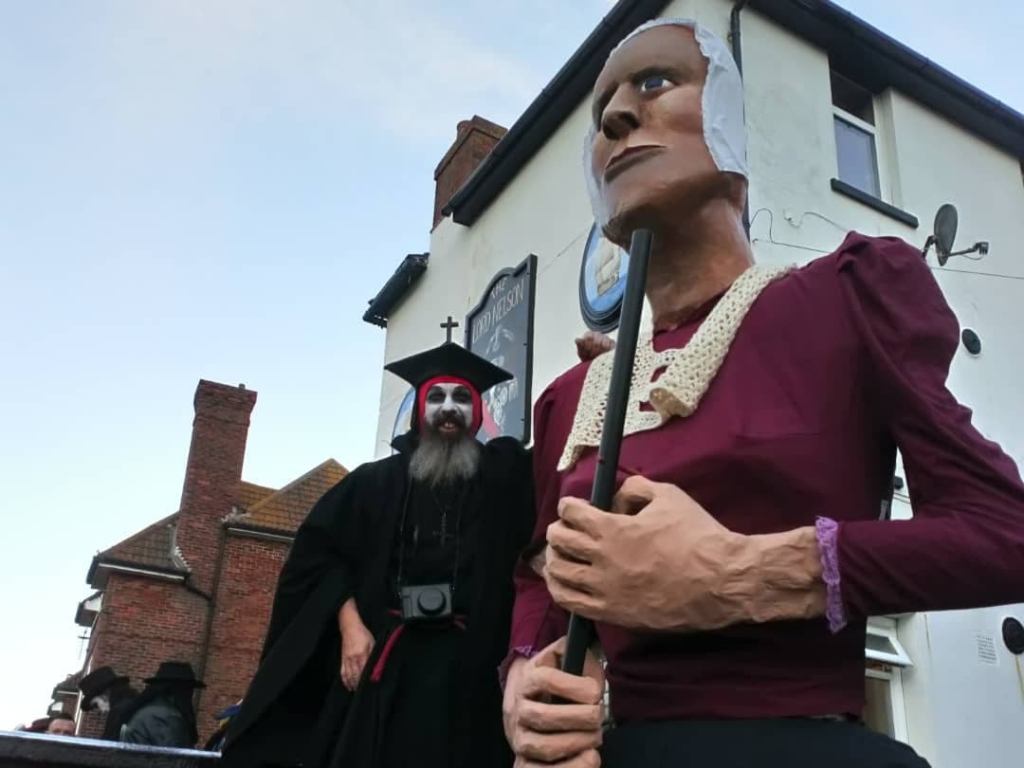The Hastings Giants are fine examples of recent traditions firing the imagination and quickly working their way into local folklore. These much-loved gargantuans have been a part of community events such as the Hastings Old Town Carnival, Jack In The Green, the Hastings Bonfire, and the Hastings Pirate Weekend (arrrr, there be such a thing, that there be) since the 1990s, although for some of that time they’ve been in hibernation.
Life is duller and less magical without them.
Mark Duncan, Giant Custodian
The current custodian of the Hastings Giants, Mark Duncan (seen with Hannah in the image at the bottom of this article), explained to Tradfolk.co that they first started appearing at local festivals and gatherings in the 1990s. “Hannah the Witch took part in Jack In The Green for about 15 years before being put into storage in about 2007. She was given to me in 2019 when her keepers moved away as they didn’t want her to leave the area. I spent about a year restoring her.”


“Hannah was originally built by local giant builder, Derek Binns, in the early 90s,” explains Mark Duncan. “He made many giants around that time but, unfortunately, only Hannah and Guy Fawkes now remain. There was a resurgence of giant building in the late 80s and early 90s that Derek was part of. It was probably inspired by the growing success of the Hastings Jack In The Green (JITG). Derek also built other procession characters such as Ninnies and Beasts that used to be in the JITG procession. Some of the chaps who are involved in Carshalton Straw Jack also built giants then, but none of those remain, either.”

As Mark points out, Hannah the Witch is often seen in the company of Guy Fawkes, a giant that belongs to Hastings Borough Bonfire Society, and a chap named Mr Fishy, formerly a member of the Eastbourne Giants, where he went by the rather more distinguished name of Herne. Mark says he’d like to build more giants but needs a little more help with his current brood before he can get around to it.
As for his own path into the Land of the Giants, Mark was involved in acting and the staging of plays in Hastings for just over a decade, finding his way into Mumming as a byproduct. He explains, “I’m motivated to help keep traditions going as they are dying out all over England and I think life is duller and less magical without them. I’ve liked giants since I first saw them at JITG in the 90s, never realising Hannah would ever live with me, and became more interested when I visited Ath in Belgium for the giant festival they have there, which is truly spectacular and has been going for hundreds of years. There are a few people around who are trying to bring giants back into events, and I have found myself unexpectedly in a good position to be part of that.”
Giants, you say?
Dancing, or Pageant Giants, sit alongside similar creations such as Ninnies and Beasts. They’re often seen dancing alongside Jack O’The Green, another handmade figure commonly seen at folk rituals and events.
Keeping things reasonably brief, Ninnies are big-headed figures, usually not free-standing, not usually as tall as the giants. They often take the form of a very large head on the shoulders of the person operating it, and as such, they look like large versions of Bobblehead toys.
A Beast, on the other hand, does exactly what it says on the tin. It can be a dragon, a fish, a cow… whatever the imagination requires. Beasts are often seen dancing with Morris sides. A particularly well-known example of a Beast would be the Hobby Horse.
Jack O’the Green is a cavorting woodland sprite, usually depicted as a tall framework decorated in flowers and other verdant greenery. This can either be stationary or a person can stand inside it and move it about. As the custom has it, he must die before the carnival is over, unleashing the spirit of summer.
The British Isles Giants Guild (BIGG, obviously – welcome to a whole new rabbit hole) lists over 80 known giants, although they last updated their website in the year 2000, so who knows how effectively these creatures have spawned?



Who was Hannah the Witch?
Hannah Clarke, on whom Hannah the Witch giant is based, is said to have been living at the Stagg Inn, Hastings, around 1665. In an attempt to ward off the plague using witchcraft, she sealed up her two cats in a chimney. This was not an unusual thing to have done – other reports of similar activities exist, most famously in the case of the Pendle Witches. Indeed, the Stagg Inn still has the cats, mummified and on display in a glass case in the bar area.
Of course, the existence of the cats does not mean that Hannah herself existed. Her story is thought to be local myth, along with the notion that she protected the town from French invasion and tax inspectors. She is, however, remembered in the form of this glorious Hastings Giant, and lends her name to a local Morris side, Hannah’s Cat.
For more information on the Giants of Hastings, head to their Facebook page.





One Comment